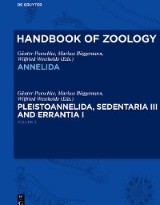Details

Pleistoannelida, Sedentaria III and Errantia I
1. Aufl.
|
CHF 312.15 |
|
| Verlag: | De Gruyter |
| Format: | EPUB |
| Veröffentl.: | 23.11.2020 |
| ISBN/EAN: | 9783110388855 |
| Sprache: | englisch |
| Anzahl Seiten: | 491 |
DRM-geschütztes eBook, Sie benötigen z.B. Adobe Digital Editions und eine Adobe ID zum Lesen.
Beschreibungen
<p>This book is the third volume in a series of 4 volumes in the Handbook of Zoology series treating morphology, anatomy, reproduction, development, ecology, phylogeny, systematics and taxonomy of polychaetous Annelida. </p>
<p>It is devoted to the remaining Sedentaria and the first branches of Errantia. These sedentary polychaetes are Terebellida and Arenicolida, all of which are tube-dwelling and deposit feeders. The tubes may be simple burrows stabilized by mucus or the tubes are highly sophisticated often really aesthetic structures build-up of sediment grains glued together by their secretion. Although the former possess anterior appendages used for collecting food particles, these are likely not modified palps rather than a new acquisition. Many of these species are adapted to occur within environments characterized by low oxygen supply and so many members of these taxa possess elaborated branchiae, usually positioned on a number of anterior body segments except for Maldanidae which look like bamboo sticks and thus earned their common name bamboo worms. Members of Arenicolida and Maldanida may occur in high abundance and as such they create biogenically graded sediment beds. </p>
<p>The Errantia part starts with Myzostomida, a group of symbiotic animals associated with echinoderms which have been variously placed within the tree of life. As such they show numerous adaptations to this specific mode of life. The next group discussed within Errantia is Protodrilida, a taxon comprising four families of the former archiannelids which belong to the interstitial fauna. Most likely they evolved by miniaturization from larger ancestors. In contrast to typical errants they do not possess well-developed parapodia and antennae. This taxon is followed by Eunicida characterized by possession of a specific jaw apparatus situated ventrally in the foregut and associated with specific musculature. Also being a species rich group showing various feeding modes some of the smallest and the largest members belong to this taxon. </p>
<p></p>
<p>It is devoted to the remaining Sedentaria and the first branches of Errantia. These sedentary polychaetes are Terebellida and Arenicolida, all of which are tube-dwelling and deposit feeders. The tubes may be simple burrows stabilized by mucus or the tubes are highly sophisticated often really aesthetic structures build-up of sediment grains glued together by their secretion. Although the former possess anterior appendages used for collecting food particles, these are likely not modified palps rather than a new acquisition. Many of these species are adapted to occur within environments characterized by low oxygen supply and so many members of these taxa possess elaborated branchiae, usually positioned on a number of anterior body segments except for Maldanidae which look like bamboo sticks and thus earned their common name bamboo worms. Members of Arenicolida and Maldanida may occur in high abundance and as such they create biogenically graded sediment beds. </p>
<p>The Errantia part starts with Myzostomida, a group of symbiotic animals associated with echinoderms which have been variously placed within the tree of life. As such they show numerous adaptations to this specific mode of life. The next group discussed within Errantia is Protodrilida, a taxon comprising four families of the former archiannelids which belong to the interstitial fauna. Most likely they evolved by miniaturization from larger ancestors. In contrast to typical errants they do not possess well-developed parapodia and antennae. This taxon is followed by Eunicida characterized by possession of a specific jaw apparatus situated ventrally in the foregut and associated with specific musculature. Also being a species rich group showing various feeding modes some of the smallest and the largest members belong to this taxon. </p>
<p></p>
<p><strong>Günther Purschke,</strong> <strong>Wilfried Westheide,</strong> University of Osnabrück, Germany; <strong>Markus Böggemann,</strong> University of Vechta, Germany </p>
Diese Produkte könnten Sie auch interessieren:

Auditory Signal Processing

von: Daniel Pressnitzer, Alain de Cheveigne, Stephen McAdams, Lionel Collet

CHF 236.00















